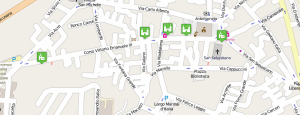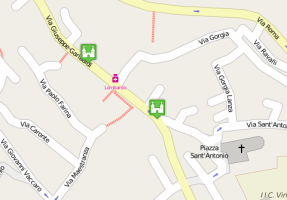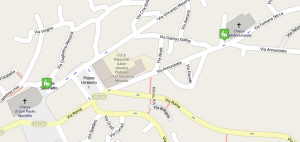Baroque of Palazzolo Acreide
La città
The city, included in the Unesco Heritage list within the site "The late Baroque cities of the Val di Noto", has Greek origins and is located in the Iblei Mountains and not far from the Anapo river and the Rupestrian Necropolis of Pantalica (inserted in the list of the Unesco Heritage: Syracuse and the rock necropolis of Pantalica ".
First Group: Corso Vittorio Emanuele
To enlarge the image of the maps click on them. For the interactive and search functions, please refer to the "Tourist Map of the Baroque"
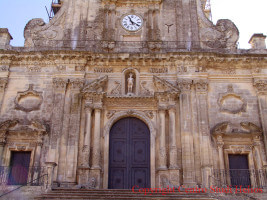 The Church of S. Sebastiano has a spectacular staircase and, with its elegantly worked façade, overlooks the Piazza del Popolo imposingly. The first building consecrated to S. Sebastiano was erected, with a single nave, at the end of the 1609th century on the same site where a small church dedicated to S. Rocco already existed; enlarged in 1693, it was almost completely destroyed by the earthquake of 35. The Church rose from the rubble of the earthquake at the beginning of the eighteenth century, always on the same site but with a basilica with three naves. The building has a monumental facade 1783 meters high and made with Hyblean freestone; conceived by the Syracusan architect Mario Diamante, it is divided into three superimposed orders decorated according to the late Renaissance style; it has a fine portal and a beautiful bell loggia. The interior, richly worked with valuable stuccos dating back to XNUMX, houses and houses numerous paintings including that of S. Rita by Pietro Novelli, that of S. Margherita da Cortona by Vito D'Anna and that of S. Luigi Gonzaga by Giovanni Tanasi. All the altars are made with precious marbles and with beautiful statues of saints. The central nave is decorated with three large nineteenth-century frescoes; to remember also a monumental organ of the nineteenth century, built by Carlo Del Piano, which appears to be among the most beautiful in Sicily.
The Church of S. Sebastiano has a spectacular staircase and, with its elegantly worked façade, overlooks the Piazza del Popolo imposingly. The first building consecrated to S. Sebastiano was erected, with a single nave, at the end of the 1609th century on the same site where a small church dedicated to S. Rocco already existed; enlarged in 1693, it was almost completely destroyed by the earthquake of 35. The Church rose from the rubble of the earthquake at the beginning of the eighteenth century, always on the same site but with a basilica with three naves. The building has a monumental facade 1783 meters high and made with Hyblean freestone; conceived by the Syracusan architect Mario Diamante, it is divided into three superimposed orders decorated according to the late Renaissance style; it has a fine portal and a beautiful bell loggia. The interior, richly worked with valuable stuccos dating back to XNUMX, houses and houses numerous paintings including that of S. Rita by Pietro Novelli, that of S. Margherita da Cortona by Vito D'Anna and that of S. Luigi Gonzaga by Giovanni Tanasi. All the altars are made with precious marbles and with beautiful statues of saints. The central nave is decorated with three large nineteenth-century frescoes; to remember also a monumental organ of the nineteenth century, built by Carlo Del Piano, which appears to be among the most beautiful in Sicily.
Judica Palace
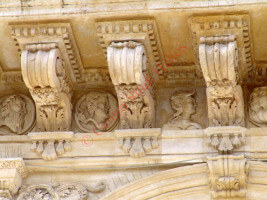 In Corso Vittorio Emanuele n. 10. Built on two levels in the XNUMXth century. The palace testifies to the fusion of two styles: late baroque and neo-classical. The central portal is imposing, limited on the sides by pilasters decorated with Corinthian capitals. On the second level there are four balconies with a baroque shape and equipped with richly decorated shelves in neoclassical style.
In Corso Vittorio Emanuele n. 10. Built on two levels in the XNUMXth century. The palace testifies to the fusion of two styles: late baroque and neo-classical. The central portal is imposing, limited on the sides by pilasters decorated with Corinthian capitals. On the second level there are four balconies with a baroque shape and equipped with richly decorated shelves in neoclassical style.
Messina-Ruiz Palace.
In Corso Vittorio Emanuele n. 18 immediately next to the Iudica building. Built in the eighteenth century. The unfinished facade is in the Baroque style.
Pizzo Palace.
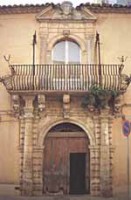 Corso Vittorio Emanuele n. 36. Baroque palace of the XVIII century. The central portal is surmounted by a balcony closed by a rounded wrought iron railing and supported by five shelves: three central with masks, the two lateral decorated with acanthus leaves. The balcony is surmounted by a coat of arms.
Corso Vittorio Emanuele n. 36. Baroque palace of the XVIII century. The central portal is surmounted by a balcony closed by a rounded wrought iron railing and supported by five shelves: three central with masks, the two lateral decorated with acanthus leaves. The balcony is surmounted by a coat of arms.
Church of the Assumption or of the Immaculate Conception
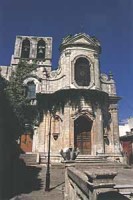 Located at the end of Corso Vittorio Emanuele. Built between 1753 and 1765. It has a convex façade, the only example in the town, it is divided into two orders: the first level is characterized by the portal with two shell-shaped niches; the second level contains a large window. On the left of the facade the bell tower is visible, which seems to have been built previously.
Located at the end of Corso Vittorio Emanuele. Built between 1753 and 1765. It has a convex façade, the only example in the town, it is divided into two orders: the first level is characterized by the portal with two shell-shaped niches; the second level contains a large window. On the left of the facade the bell tower is visible, which seems to have been built previously.
Second Group: Via Garibaldi
Pricone Palace
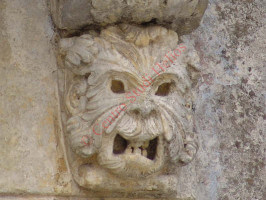 Palazzo Pricone (ex Ferla di Tristaino) stands on Via Garibaldi at n. 115 and is considered as the oldest noble palace in Palazzolo Acreide. The façade, on two levels, of the building is simple in appearance, the first level has an arched portal surmounted by the coat of arms of the Ferla family. The second level has four baroque balconies enclosed by rounded wrought iron railings and supported by corbels decorated with valuable bas-reliefs depicting grotesque masks.
Palazzo Pricone (ex Ferla di Tristaino) stands on Via Garibaldi at n. 115 and is considered as the oldest noble palace in Palazzolo Acreide. The façade, on two levels, of the building is simple in appearance, the first level has an arched portal surmounted by the coat of arms of the Ferla family. The second level has four baroque balconies enclosed by rounded wrought iron railings and supported by corbels decorated with valuable bas-reliefs depicting grotesque masks.
Caruso Palace
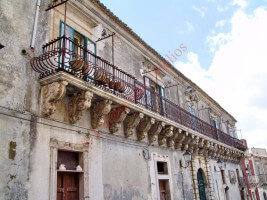 The Palace built in the eighteenth century. stands on Via Garibaldi at n. 127, over time it has changed its name according to the owners: Palazzo Cafici, Palazzo Iudica and finally Palazzo Caruso. The Palace is characterized by what is considered one of the longest baroque balconies in the world. The wrought iron balcony is supported by twenty-seven carved corbels depicting funny masks with different expressions.
The Palace built in the eighteenth century. stands on Via Garibaldi at n. 127, over time it has changed its name according to the owners: Palazzo Cafici, Palazzo Iudica and finally Palazzo Caruso. The Palace is characterized by what is considered one of the longest baroque balconies in the world. The wrought iron balcony is supported by twenty-seven carved corbels depicting funny masks with different expressions.
Third Group: San Paolo district
St Paul's Church ![]()
The Church of S. Paolo (patron saint of the city) was built around the middle of the seventeenth century on the same site where a small church dedicated to S. Sofia already existed. The building was destroyed by the terrible earthquake of 1693 but its rebuilding immediately began, probably based on a project by Vincenzo Sinatra. It is assumed that the reconstruction of the Church of San Paolo was completed between 1720 and 1730. The Church represents one of the most beautiful and interesting examples of the local Baroque: it has a fine staircase arranged on two ramps of different widths and a splendid tower facade. , divided into three orders cadenced by arches and columns with Corinthian capitals. Of great visual effect are the large portico, the beautiful portal, the refined bell tower, the rich sculptural decorations, the friezes and statues that enrich the façade. The Church has a basilica shape with three naves with two side apses that enclose the two minor naves; inside there are eleven altars, a precious 700th century crucifix, an ancient organ, several XNUMXth century paintings by the painter Joseph Crestadoro.
Church of the Annunciation
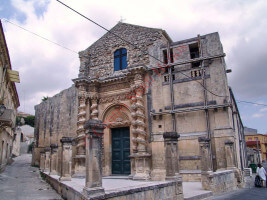 Considered the oldest church in Palazzolo, probably built in the 1693th-XNUMXth century; destroyed by the earthquake of XNUMX it was rebuilt in the eighteenth century on the same site. by architect Matteo Tranisi, is the jewel of art. The exterior of the church is distinguished by the large portal, characterized by four coupled twisted columns, richly adorned with vine shoots and friezes, which represent rural motifs: quinces, pomegranates, grapes and other life-sized fruit. The facade is incomplete.
Considered the oldest church in Palazzolo, probably built in the 1693th-XNUMXth century; destroyed by the earthquake of XNUMX it was rebuilt in the eighteenth century on the same site. by architect Matteo Tranisi, is the jewel of art. The exterior of the church is distinguished by the large portal, characterized by four coupled twisted columns, richly adorned with vine shoots and friezes, which represent rural motifs: quinces, pomegranates, grapes and other life-sized fruit. The facade is incomplete.
Note: with the symbol ![]() the monuments expressly mentioned in the Unesco recognition document are indicated. We invite you to read the Unesco card for the distinction between the "Unesco Site" as a whole included in the "WHL", the areas effectively recognized and individual monuments testifying to the Baroque of the Val di Noto located within the areas (core zones) included in the WHL.
the monuments expressly mentioned in the Unesco recognition document are indicated. We invite you to read the Unesco card for the distinction between the "Unesco Site" as a whole included in the "WHL", the areas effectively recognized and individual monuments testifying to the Baroque of the Val di Noto located within the areas (core zones) included in the WHL.
[wp_ad_camp_1]
Baroque of Palazzolo Acreide


